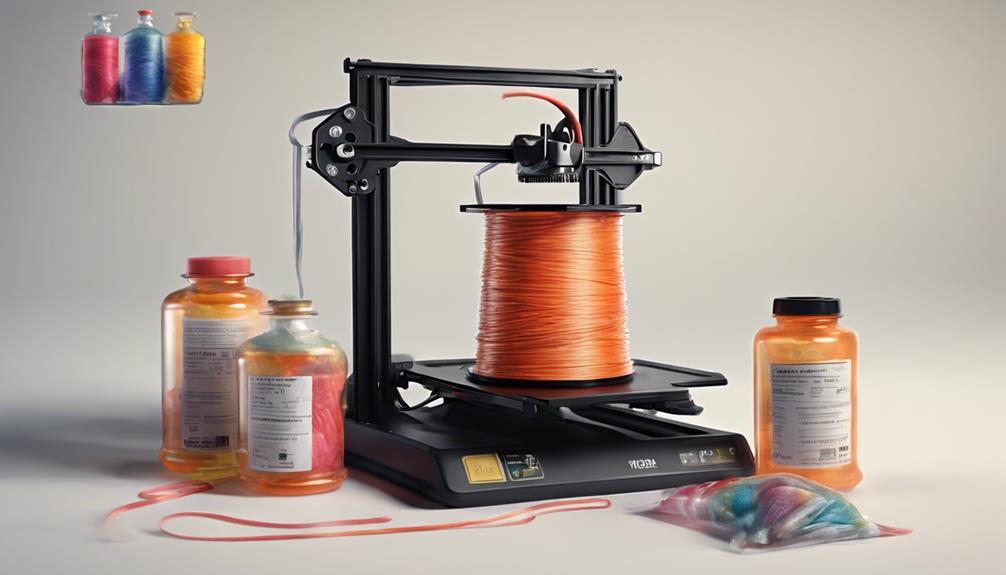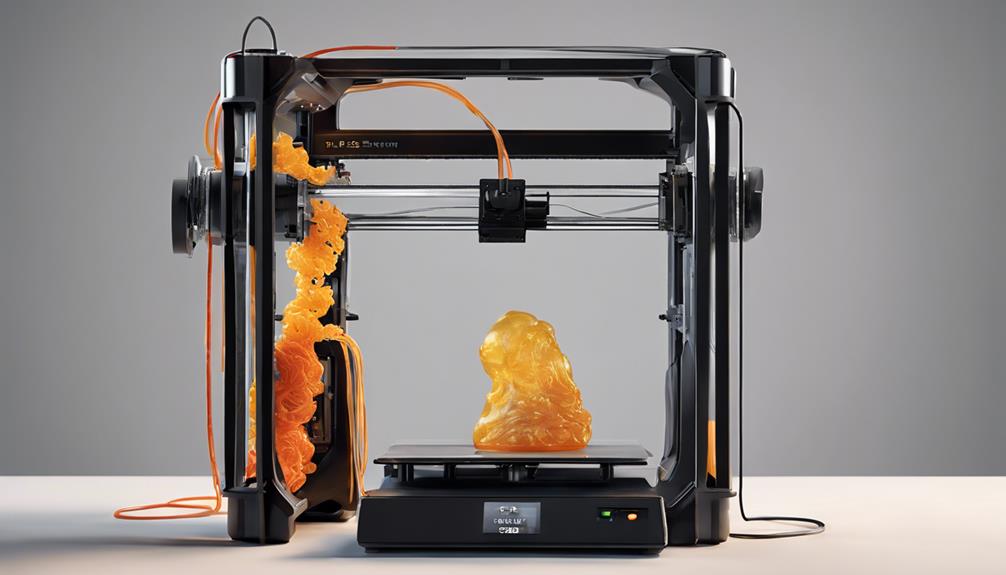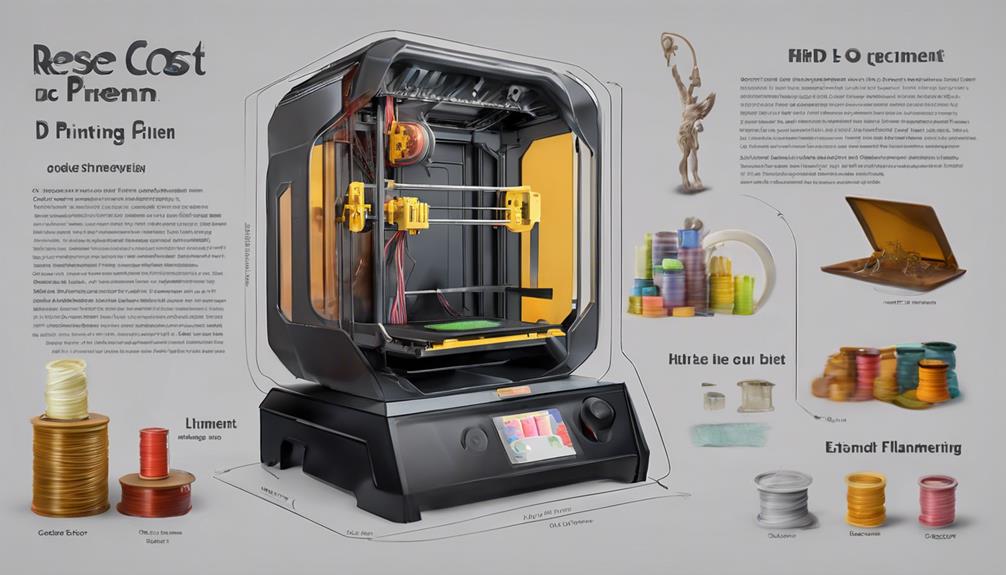When it comes to the world of 3D printing, the debate between resin and filament technologies is not merely about the initial investment in a printer. The ongoing operational costs play a significant role in determining the overall cost efficiency of a printing project. Whether it's the recurring expenses of filament spools or the additional consumables and maintenance requirements of resin printing, each option presents its own set of financial considerations. Understanding the intricate balance between upfront costs and long-term expenses is key to making an informed decision that aligns with both budgetary constraints and project requirements.
Filament Vs Resin Cost Breakdown

When evaluating the cost breakdown between filament and resin for 3D printing, it is essential to consider the price differentials and additional expenses associated with each printing material.
Filament, such as PLA, ABS, or PETG, typically costs around $20 for a 1Kg spool.
On the other hand, resin prices range from $15 to $45 for 500ml and $28 to $80 for 1 liter. Additionally, resin printers incur extra costs like resin tank replacements, priced at around $40, as well as expenses for isopropyl alcohol, protective equipment like gloves and face masks, and UV curing lamps.
These additional expenses need to be factored in when determining the overall cost effectiveness of using filament or resin for 3D printing projects.
Analysis of FDM Printer Costs
An examination of the costs associated with FDM printers reveals key factors influencing their affordability and practicality for various 3D printing applications. The cost of FDM printers varies based on their quality, size, and features, ranging from $150 to $1500.
For instance, the popular Ender 3 printer by Creality is priced around $250. Additional expenses such as shipping and import fees should also be considered. Unlike resin printers, FDM printers have no hidden costs associated with resin tanks, isopropyl alcohol, or UV curing lamps.
While FDM printers offer a cost-effective entry point into 3D printing, they may lack the high level of detail achievable with resin printers.
Overview of Resin Printer Expenses

What are the essential expenses associated with owning a resin 3D printer? When considering the cost of owning a resin printer, it's important to account for various expenses beyond just the initial purchase. Additional costs may include resin tank replacement, isopropyl alcohol for cleaning, protective equipment like gloves and a face mask, as well as a UV curing lamp for post-processing. Here is a breakdown of these essential expenses in a simple table format:
| Expense | Estimated Cost |
|---|---|
| Resin tank replacement | $40 |
| Isopropyl alcohol | $27 per gallon |
| Protective equipment | Costs vary |
| UV curing lamp | Around $28 |
Comparing Resin Prices and Add-Ons
The comparison of resin prices and additional costs provides valuable insights into the economic considerations associated with resin 3D printing. Resin prices typically range from $20 to $75 per 1 liter or 500g, varying based on the type of resin chosen.
In addition to resin costs, there are several essential add-ons required for resin printing. These include protective gear like face masks, gloves, and goggles, isopropyl alcohol priced at $27 for 1 gallon, a UV curing lamp costing around $28, and the need for resin tank replacements that can range from $40 to $60.
To guarantee safety and efficiency, considerations such as storage containers and extractor fans must also be factored into the overall cost analysis.
Total Cost Comparison Analysis

When evaluating the total cost comparison between filament and resin printing technologies, it is vital to take into account various factors beyond the initial purchase price of the printers and materials. These include ongoing expenses like maintenance, replacement parts, and consumables. Additionally, considering the differences in material costs and the need for additional equipment such as protective gear and curing lamps is essential for an accurate cost analysis. Below is a table highlighting some key cost factors to take into consideration when comparing filament and resin 3D printing:
| Cost Factors | Filament Printing | Resin Printing |
|---|---|---|
| Initial Printer Cost | $200-$500 | $180-$900 |
| Material Cost | $20 per 1Kg spool | $15-$45 for 500ml or $28-$80 for 1 liter |
| Additional Equipment | None | Resin tank replacement ($40), isopropyl alcohol, UV curing lamp, protective gear |
| Maintenance Costs | Low | Moderate to High |
Key Considerations for Cost Efficiency
When evaluating cost efficiency for 3D printing, it is imperative to carefully consider various factors beyond the initial investment in equipment and materials. Factors such as ongoing maintenance costs, operational expenses, and the total cost of ownership play a significant role in determining the overall cost-effectiveness of a 3D printing setup.
Regular maintenance, replacement parts, energy consumption, and even the cost of post-processing materials should all be taken into account when making a cost-efficient decision. Additionally, considering the scalability of the chosen printing technology and its impact on long-term costs can help in making a more informed and sustainable investment.
Making an Informed Cost Decision

To effectively navigate the world of 3D printing costs, prudent consideration of all financial aspects is essential. When making an informed cost decision between resin and filament printing, it is imperative to factor in not only the initial printer cost but also ongoing expenses such as filament or resin prices, additional materials like protective gear and curing equipment, maintenance costs, and the overall cost of ownership.
Understanding the total cost of each printing method, including hidden expenses, can help users make a more financially sound decision that aligns with their budget and printing requirements. Conducting thorough research and cost analysis beforehand can lead to a more cost-effective and efficient 3D printing experience.
Frequently Asked Questions
Can Resin Printers Use Filament Instead of Resin?
Resin printers cannot use filament as they operate on distinct technologies – resin 3D printing uses photopolymerization while filament printers use thermoplastic filaments. Attempting to use filament in a resin printer would damage the equipment and compromise print quality.
How Often Should the Resin Tank Be Replaced?
The lifespan of a resin tank depends on usage and maintenance. Generally, it can last 2-3 liters of resin with proper care. Regularly inspect for cloudiness, scratches, or leaks. Replace promptly to prevent print failures and guarantee print quality.
Are There Any Eco-Friendly Resin Options Available?
Eco-friendly resin options are emerging in the 3D printing market, addressing environmental concerns. These resins promote sustainability by utilizing biodegradable or plant-based materials, reducing the carbon footprint of the printing process. Consider these options for eco-conscious printing practices.
What Is the Typical Shelf Life of Resin?
Just as a tree's rings tell its story, resin's shelf life speaks volumes about its stability. Typically lasting 6-12 months unopened, proper storage in a cool, dark place can extend this, ensuring best printing results.
Do FDM Printers Require Regular Maintenance?
FDM printers require regular maintenance to guarantee peak performance. Tasks may include cleaning the print bed, unclogging nozzles, and calibrating the machine. Regular upkeep is essential for consistent printing quality and longevity of the printer.
Conclusion
To summarize, when comparing the cost of resin and filament printing, it is crucial to take into account both the initial printer costs and ongoing expenses.
One interesting statistic to note is that while filament printing may have a higher upfront cost, the overall material costs are lower compared to resin printing.
This underscores the importance of thoroughly analyzing all expenses to guarantee cost efficiency in 3D printing projects.